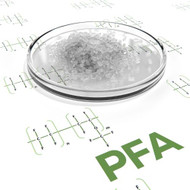PFA: Properties, Limitations and Applications
History
Perfluoroalkyl alkanes (PFAs) are a subset of fluorinated hydrocarbons conceptualized as fluorinated analogs of hydrocarbons. They have unique properties that set them apart from per- and polyfluoroalkyl substances (PFAS). The key breakthrough that sparked significant interest in fluorinated hydrocarbons was the discovery of PTFE (Teflon) by DuPont in 1938. Between the 1950s and 1970s, scientists explored the synthesis of fully fluorinated alkanes for applications in electronics, aerospace, and nuclear sectors, where chemically and thermally stable insulating materials were critical. By the 1990s, PFAs found increasingly specialized applications as solvents and carriers for sensitive chemical processes and as tracers in atmospheric studies. Over the last two decades, however, the PFAS family, including perfluoroalkyl alkanes, has faced criticism due to environmental persistence, bioaccumulation, and potential health risks. Despite these concerns, PFAs continue to be used in niche applications, such as lubricants for aerospace and industrial machinery, specialized heat transfer systems, and inert components in sensitive chemical processes.
Quick Highlights
-
Perfluoroalkyl alkanes (PFAs) are fluorinated analogs of hydrocarbons discovered in the early 1940s.
While they offer unmatched performance in aerospace, electronics, and nuclear applications, PFAs have faced increasing criticism and regulatory scrutiny over the last two decades.
Synthesized
There are three major ways PFAs can be synthesized. Electrochemical fluorination involves subjecting hydrocarbons dissolved in hydrogen fluoride (HF) to an electric current. This method, developed by Simons in the 1940s, is scalable for industrial production of both linear and branched isomers. However, HF is highly corrosive, the process is energy-intensive, and it produces undesired partially fluorinated compounds and byproducts. Direct fluorination involves treating hydrocarbons with elemental fluorine gas. While this route yields pure PFAs with minimal isomerization, fluorine gas is highly reactive, requires specialized equipment for safe handling, and poses a risk of violent exothermic side reactions. The third method exploits fluoroalkyl radicals to grow perfluoroalkyl chains in a stepwise fashion. This method is less common for synthesizing straight-chain PFAs but is used for related compounds. Depending on their chain length, PFAs are liquids or gases at room temperature, and as a consequence, they are unsuitable for traditional polymer processing methods such as molding or extrusion. Instead, after purification, PFAs can be handled in their low-viscosity liquid state, being incorporated into systems (e.g., inert solvents), poured, pumped, or sprayed in industrial processes. They can also be used in coating applications, sometimes even combined with curing agents. Alternatively, PFAs can be encapsulated in fluoropolymers or other matrices for solid-state applications.
PFAs generally have lower densities than other fluorinated materials or polymers. Short-chain PFAs are gases, while longer-chain PFAs are liquids at room temperature. Their boiling points are significantly lower than those of analogous hydrocarbons and increase with molecular weight.
Quick Highlights
- PFAs are synthesized through electrochemical fluorination, direct fluorination, or fluoroalkyl radical chain formation.
- Since PFAs are liquids or gases at room temperature, they are processed in their low-viscosity liquid state or encapsulated in other matrices for solid-state applications.
- PFAs exhibit lower densities, with short-chain PFAs being gases and longer-chain PFAs being liquids.
- Their boiling points are lower than those of analogous hydrocarbons and increase with
- molecular weight.
Thermal Resistance
PFAs demonstrate remarkable thermal resistance, decomposing at temperatures above 400 °C (752 °F), depending on chain length and structure. They also have low thermal conductivity, making them ideal for insulation. Compared to analogous hydrocarbons, PFAs have a low thermal expansion coefficient, often attributed to the rigidity of the carbon–fluorine bond, which ensures dimensional stability across varying temperatures. Moreover, PFAs are inherently non-flammable, resist ignition, and do not support combustion.
Quick Highlights
- PFAs exhibit thermal resistance up to 400 °C (752 °F), low thermal conductivity, and a low thermal expansion coefficient compared to analogous hydrocarbons.
- They are inherently non-flammable, resist ignition, and do not support combustion.

Chemical Resistance & Dielectric
PFAs are chemically inert to acids, bases, and most organic and inorganic reagents. This inertness stems from the carbon-fluorine bond, one of the strongest in organic chemistry, making PFAs resistant to oxidation, reduction, and hydrolysis. Additionally, PFAs have very low polarizability, resulting in low reactivity with other compounds or materials. PFAs are both hydrophobic and lipophobic, repelling water and oil due to their low surface energy. This property imparts anti-adhesion and non-stick behavior, making PFAs effective in water- and stain-resistant applications.
PFAs have some of the lowest dielectric constants among insulating materials, reducing signal loss in electronic applications. They also exhibit a low dissipation factor, ensuring minimal energy loss during insulation. PFAs have excellent resistivity and maintain their electrical integrity under high voltages. They are highly resistant to electrical breakdown caused by corona discharge, as well as ion migration, maintaining their properties even in moist or chemically aggressive environments.
Quick Highlights
- PFAs are chemically inert and resistant to oxidation, reduction, and hydrolysis.
- They repel both water and oil, leading to anti-adhesion and non-stick properties.
- PFAs are excellent insulators with low dielectric constants and dissipation factors.
- They resist electrical breakdown and ion migration, maintaining performance under harsh conditions.
Sustainability
While PFAs offer unmatched performance in extreme environments, their environmental impact is significant. The production process involves hazardous chemicals, such as HF or fluorine gas, and is highly energy-intensive. PFAs' inert nature contributes to environmental persistence and bioaccumulation, raising concerns about their long-range atmospheric transport, contamination of remote areas, and leaching into water systems. These issues can adversely affect ecosystems and human health, including risks of cancer, developmental issues, and immune system impacts. Disposal is also challenging, as PFAs resist conventional treatment methods, including incineration and chemical degradation, and incomplete incineration can release toxic byproducts. Increased regulatory scrutiny has led to bans and restrictions, driving research into sustainable alternatives and cleanup initiatives.
Quick Highlights
- The environmental impact of PFAs is significant, driven by energy-intensive production, persistence, bioaccumulation, and health risks.
- While PFAs offer unmatched performance, stricter regulations, efficient cleaning strategies, and sustainable alternatives are necessary to mitigate their environmental footprint.





